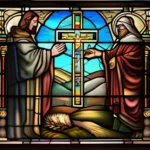Explore the history, structure, and significance of the Old Testament in Christian faith.
The Old Testament is a foundational text for Christianity, containing stories, laws, and prophecies that have shaped the beliefs and practices of this religion. In this article, we delve into the Old Testament’s origins, its structure, and its impact on Christianity.
The Origins of the Old Testament
Imagine, for a moment, that the Old Testament is like a vast library filled with scrolls and tablets. How did these texts come to be? When we delve into the history of the Old Testament in Christianity, we’re essentially peeling back layers of time to uncover its origins.
The journey begins with the authors, who were as diverse as the stories they wrote. Think of Moses, a humble shepherd turned prophet; or King David, a warrior and songwriter; or the anonymous prophets whose words still resonate today. Each writer left behind not just their personal histories but also pieces of a grand narrative that would shape future generations.
The compilation process was equally fascinating. Over centuries, these texts were collected and organized into a coherent whole. The Samaritan Pentateuch, for instance, shows how different communities interpreted the same stories in unique ways. Yet, all of these writings share a common thread—the promise of a covenant between God and His people.
Another intriguing aspect is the role of the priesthood and scribes in preserving these texts. They acted as custodians of knowledge, copying and distributing these sacred scrolls with meticulous care. It’s almost like they were guardians of an ancient code, ensuring that the stories remained intact through generations.
The process wasn’t just about collecting words on paper; it was also about shaping a community’s identity and understanding of their place in history. The Old Testament, therefore, is not merely a historical document but a living tapestry woven with threads of faith, hope, and divine purpose.
The Structure of the Old Testament
The Old Testament, often seen as a dense forest of texts and themes, is structured into several sections that guide us through its vast landscape. Imagine this structure as a map to navigate the complex terrain of ancient history, prophetic messages, and legal codes. The division into books, further broken down into sections, serves as signposts marking significant moments in the journey from the origins of Israelite culture to the prophesies leading up to the coming of Christ.
Starting with the Pentateuch, or the first five books (Genesis, Exodus, Leviticus, Numbers, and Deuteronomy), we find ourselves at the heart of a narrative that begins in the Garden of Eden and culminates with Moses leading Israel out of Egypt. This initial section sets the stage for understanding not just the history but also the moral and ethical framework that guides much of Christian belief.
Following the Pentateuch, History Books like Joshua, Judges, Ruth, 1 & 2 Samuel, and 1 & 2 Kings recount the tumultuous and often chaotic period of Israel’s history. These stories paint a picture of God’s faithfulness and the people’s repeated failures, serving as cautionary tales for future generations.
The Wisdom Books, including Job, Psalms, Proverbs, Ecclesiastes, and Song of Solomon, offer profound insights into human nature and the search for meaning. They explore themes of justice, suffering, and the value of life in a way that resonates with both ancient and modern audiences.
The Major Prophets (Isaiah, Jeremiah, Lamentations, Ezekiel, Daniel) and the Minor Prophets (Hosea through Malachi) provide a rich tapestry of warnings, promises, and visions. These texts often use vivid metaphors to convey complex messages about righteousness, judgment, and redemption. They act as prophetic windows into the future, hinting at the coming Messiah.
Each section of the Old Testament has its unique voice and purpose. Together, they form a mosaic that tells the grand story of God’s relationship with humanity. Whether you delve deep into Genesis, explore the dramatic narratives in Judges, or ponder the philosophical questions posed by the Wisdom Books, each piece fits together like puzzle pieces to create a comprehensive understanding of the Old Testament’s structure and significance.
By exploring these different sections, we gain not only insight into the history and culture but also a deeper appreciation for the interconnectedness of God’s plan throughout time. It’s as if every book and section serves as a chapter in an epic novel that ultimately leads to the full revelation found in the New Testament.
So, let us journey through these sections with curiosity and reverence, seeking to uncover the treasures hidden within each one. For in understanding the structure of the Old Testament, we find not just historical records but also timeless truths and profound wisdom for living a life dedicated to God’s will.
Key Stories in the Old Testament
Imagine opening a grand ancient library, filled with scrolls and manuscripts that hold stories thousands of years old. The Old Testament, a crucial part of this vast collection, is like a map to understanding the very foundation of Christian faith. Let’s dive into some of its key narratives—stories that are not just tales but profound metaphors for our own lives.
First, consider the Creation story in Genesis 1-2. It’s like painting a picture of God as the ultimate artist, crafting the world with care and intention. This narrative raises questions: How do we see ourselves in this creation? Do we honor the sacredness of life, just as God honored each day He created?
The Exodus, narrated in Exodus through Deuteronomy, is another epic tale that stands out. It’s a journey from slavery to freedom, symbolizing not only the physical liberation of the Israelites but also their spiritual transformation under Moses’ leadership. What can we learn about courage and perseverance when facing our own challenges? Is it possible to turn despair into hope through faith?
The life of King David, found in 1 Samuel, 2 Samuel, and 1 Kings, is a story of both triumph and downfall. David’s journey from shepherd boy to king, then to a man with flaws, teaches us about the human condition—our strengths and weaknesses, our ability to rise from mistakes, and our capacity for deep spiritual experiences.
Each of these narratives serves as a mirror, reflecting different aspects of human nature and divine purpose. They guide believers in understanding their place within God’s plan, offering lessons on justice, leadership, and the complex relationship between faith and action.
The Old Testament stories are like chapters in an ongoing epic, each adding layers to the grand narrative of redemption. As we explore these tales, we find ourselves not just reading history but participating in a timeless dialogue about what it means to be human, to believe, and to live with purpose.
The Laws of the Old Testament
Imagine the Old Testament as a vast map, guiding us through the early history and moral landscape of humanity. The Ten Commandments, like signposts on this journey, are perhaps the most recognizable landmarks. These commandments serve as fundamental rules for living, not just in ancient times but also in our modern world.
- Thou shalt have no other gods before Me.
- Honor thy father and mother.
- No murder, adultery, stealing, false witness, or coveting.
These commandments are like a set of instructions for building a harmonious society. They reflect a divine order that goes beyond mere religious observance—guiding us in treating others with respect and fairness, which are values we should all aspire to uphold.
The dietary laws found within the Old Testament, such as avoiding pork or shellfish, may seem archaic today. However, they serve as a metaphor for the importance of clean living and abstaining from harmful substances. These laws were given in context of protecting health and preventing diseases, much like following modern food safety guidelines.
Other moral guidelines include the laws of reparation and forgiveness found in Leviticus 24:17-23. These rules teach us about justice and mercy, reminding us that our actions have consequences. They are like the gears in a well-oiled machine, ensuring that every part works together for the greater good.
The Old Testament’s moral guidelines are not just static laws; they are dynamic principles that shape our character and influence how we interact with others. By understanding these commandments and guidelines, Christians find a foundation upon which to build their faith and daily lives. It’s as if every time we break one of these commands, we’re peeling away the layers of a onion, revealing more depth to our moral existence.
Prophecies and Messianic Expectations
Imagine peeling back layers of history, like uncovering ancient scrolls that whisper tales from millennia past. The Old Testament, filled with prophetic books, serves as a cosmic roadmap predicting the arrival of the Messiah. How can we understand these prophecies without questioning their profound impact on Christian faith?
In the dramatic narrative of Old Testament prophecy, key figures like Isaiah and Jeremiah emerge as prophets who saw beyond their own time. Their visions painted a picture of a future ruler, often referred to in Hebrew as “Mashiach,” meaning anointed one—a title that resonates deeply within Christian theology.
Consider the wave of expectation these prophecies created. They described a leader who would bring salvation and establish justice, a figure who would be born in Bethlehem, suffer for humanity’s sins, and rise again from the dead. These predictions echo through time, resonating with modern Christians as they contemplate the life and teachings of Jesus Christ.
The prophets’ voices ring out, not just as ancient history but as living words that challenge us to ponder our own relationship with God. They ask: How do these prophecies shape our understanding of Jesus Christ? Are we living in anticipation of His coming or have we missed the mark?
The Old Testament’s prophetic books, then, are not just historical documents but a bridge connecting past and present, bridging the gap between divine promise and fulfillment. Each verse is a puzzle piece that fits perfectly into the larger mosaic of Christian belief, inviting us to explore further.
The Influence of the Old Testament on Christianity
Imagine peeling back the layers of a rich tapestry, where every thread tells a story that eventually weaves into the fabric of Christian faith. The Old Testament is like this intricate design; it’s not just a historical record but a profound guide to understanding the very essence of Christianity. How did the Old Testament shape Christian beliefs, practices, and theology? Let’s explore.
Think about the Psalms, those beautiful songs that echo through centuries. They are more than mere poetry—they’re windows into the heart of faith, expressing emotions, hopes, and fears that resonate with Christians today. Why do we sing ‘My soul finds rest in God alone’? Because these psalms captured the essence of human longing for divine presence, a sentiment that continues to inspire believers.
Now, consider the prophets. They were like the early warning systems of their time—voicing warnings and promises that echo through the ages. Take the book of Isaiah, with its powerful imagery of the suffering servant who bears our sorrows. Isn’t this a foreshadowing of Jesus Christ? The Old Testament prophetic books predict so much about the coming Messiah, making it hard not to see the connection between these ancient words and the New Testament.
The Law, too, is crucial. It’s like a set of instructions for living—God’s blueprint for a just society. As Christians, we don’t follow the Mosaic Law directly, but its principles shape our ethical framework. The Ten Commandments remain foundational in Christian morals, serving as a guide to live a life pleasing to God.
Moreover, stories like those of Abraham and Sarah, Moses and the Exodus, David and Goliath—they’re not just historical accounts. They are tales that teach us about faith, obedience, and trust in the face of seemingly insurmountable challenges. How can we not be inspired by Abraham’s willingness to sacrifice his son, a profound act of faith? These narratives provide rich metaphors for our own spiritual journeys.
In essence, the Old Testament is more than just a collection of ancient texts; it’s a living document that continues to influence Christian thought and practice. It serves as both a historical record and a prophetic voice, guiding Christians in their understanding of God’s plan and purpose.
Conclusion
 By understanding the Old Testament, readers will gain a deeper appreciation for the rich history and traditions of Christianity. This knowledge can enrich personal faith and provide valuable insights into the Bible as a whole.
By understanding the Old Testament, readers will gain a deeper appreciation for the rich history and traditions of Christianity. This knowledge can enrich personal faith and provide valuable insights into the Bible as a whole.











